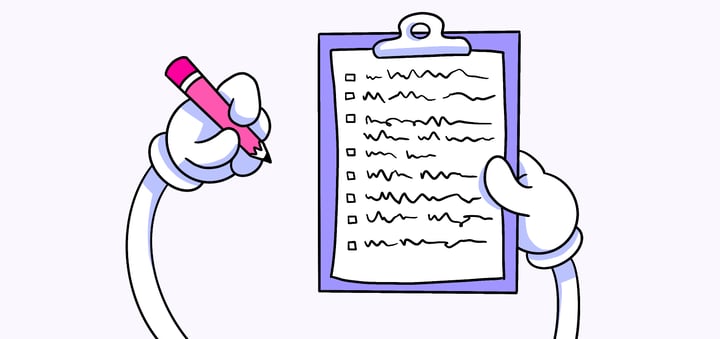Master Your Workflow with Top Task Analysis Techniques
The Ultimate Guide to Top Task Analysis. Are you struggling to understand and prioritize your tasks? Do you often find yourself overwhelmed with a never-ending to-do list? Well, fear not! In this ultimate guide, we will take you through the ins and outs of top task analysis, a powerful technique that will revolutionize the way you approach your workload.
🔩 The Nuts and Bolts:
- Top Task Analysis Enhances Efficiency: By breaking down complex tasks into smaller steps, you gain a deeper understanding of processes and streamline operations, boosting productivity and performance.
- Essential for Effective Project Management: Task analysis helps project managers develop efficient plans, accurately estimate resources, identify bottlenecks, and allocate tasks effectively, ensuring project success.
- Critical for Training and Development: Deconstructing tasks into step-by-step procedures allows trainers to create targeted programs, addressing skill gaps and accelerating the learning process for employees.
- Various Tools and Techniques Available: Task analysis can be enhanced using software tools for visualization and reporting, or manual techniques like mind mapping and flowcharts for a comprehensive view of tasks.
- Identifying and Prioritizing Tasks is Key: Start by breaking down the overall goal into actionable tasks, prioritize them based on importance and impact, and then analyze each task’s requirements and dependencies.
- Overcome Common Pitfalls: Avoid overanalyzing tasks and resistance to change by focusing on essential elements, involving employees in the process, and maintaining open communication channels.
- Integral for Risk Management: Analyzing tasks helps project managers anticipate potential risks, develop contingency plans, and identify critical paths to ensure timely project completion and mitigate issues effectively.
Understanding the Basics of Task Analysis
Before we dive into the nitty-gritty details, let’s start by defining what task analysis is all about. Task analysis is a systematic process of breaking down complex tasks into smaller, more manageable steps. By dissecting tasks, we gain a deeper understanding of the underlying processes and requirements.
Now, you might be wondering, why is task analysis so important for businesses? Well, let me tell you. Task analysis helps businesses streamline their operations, improve productivity, and enhance overall performance. By understanding tasks at a granular level, organizations can identify bottlenecks, allocate resources effectively, and eliminate redundant steps.
Furthermore, this plays a crucial role in training and development. By deconstructing tasks into step-by-step procedures, trainers can create targeted training programs that address specific skill gaps and knowledge deficiencies. This tailored approach not only accelerates the learning process but also ensures that employees are equipped with the necessary competencies to perform their roles effectively.
Moreover, task analysis is not limited to business settings. It is also widely used in various fields such as education, healthcare, and human factors engineering. In education for example, educators utilize this to design curriculum frameworks that align with learning objectives and student capabilities. While healthcare, medical professionals employ task analysis to optimize clinical processes and enhance patient care outcomes. In human factors engineering, designers apply task analysis to create user-friendly interfaces and systems that prioritize usability and efficiency.
Steps to Execute
Now that you comprehend the significance of task analysis, let’s explore the step-by-step process. This is a crucial component of user experience design, helping to understand user behavior and preferences to create more intuitive and user-friendly products and services.
This involves a systematic approach to breaking down tasks into smaller, more manageable components. By understanding the steps users take to accomplish their goals, designers can optimize processes, improve efficiency, and enhance overall user satisfaction.
Identifying the Tasks
The first step is identifying the tasks at hand. This involves breaking down the overall goal into smaller, actionable tasks. Remember, it’s crucial to be specific and precise when defining tasks, as ambiguity can lead to confusion and inefficiency. Utilizing techniques such as user interviews, surveys, and observation can help gather valuable insights into user needs and behaviors.
Prioritizing the Tasks
Once you have identified the tasks, it’s time to prioritize them. Not all tasks are created equal, and your focus should be on identifying the most critical and impactful ones. Prioritization will help you allocate your time and resources efficiently, ensuring that you tackle the most important tasks first. Consider factors such as user goals, business objectives, and project constraints when determining task priority.
Analyzing the Tasks
After prioritizing, it’s time to dig deeper into each task. This involves analyzing the requirements, dependencies, and potential roadblocks. By conducting a thorough analysis, you can identify any potential risks and develop contingency plans accordingly. This also allows for the identification of opportunities for process improvement and innovation, leading to enhanced user experiences and business outcomes.
Build something your buyers *truly* want
Subscribe to Closing the Gap—a newsletter to help makers and doers get closer to customers. Learn more.
We believe in protecting your data. Here’s our Privacy Policy.
Tools and Techniques
While the concepts is simple, there are various tools and techniques that can enhance its effectiveness. Let’s explore some of these tools and techniques.
One valuable tool for effectiveness, is the use of task analysis matrices. These matrices provide a structured way to break down tasks into smaller components, making it easier to identify key steps and potential areas for improvement. By utilizing task analysis matrices, you can gain a comprehensive view of the task at hand and make informed decisions on how to optimize processes.
Task Analysis Software
In this digital age, there are plenty of software tools available that can assist you in conducting task analysis. These tools provide features like task visualization, collaboration, and reporting, making the process more streamlined and efficient.
Another technique that can complement the software is the use of task observation. By directly observing individuals as they perform tasks, you can gain valuable insights into their workflow, potential pain points, and areas of efficiency. Observations allows for a firsthand understanding of how things are executed in real-world scenarios, providing a deeper level of analysis.
Manual Task Analysis Techniques
Not everyone prefers the digital route, and that’s perfectly fine! Manual task analysis techniques, such as mind mapping and flowcharts, can be equally effective. These techniques allow for a visual representation of tasks, helping you better understand and analyze their interdependencies.
Furthermore, conducting task interviews can be a powerful manual technique to gather insights from individuals directly involved in task execution. By engaging with stakeholders through interviews, you can uncover valuable information about task requirements, challenges faced, and potential areas for improvement. Interviews provide a human-centric approach, ensuring that the analysis is grounded in the experiences and perspectives of those performing the tasks.
UX Research Methods
Challenges in Task Analysis and How to Overcome Them
Like any other process, comes with its fair share of challenges. However, with the right strategies, these challenges can be overcome successfully.
Common Pitfalls
One common pitfall is overanalyzing tasks. It’s easy to get caught up in the minute details, losing sight of the bigger picture. To overcome this, focus on the essential elements of the task, and avoid unnecessary complexity.
Another challenge is the resistance to change. Employees may be resistant to shifting their established routines. To address this, involve them in the process, providing them with a clear understanding of the benefits and outcomes.
Furthermore, a lack of resources can hinder effective task analysis. Limited access to data or tools can impede the thorough examination of tasks. It is essential to invest in the necessary resources and technology to support comprehensive task analysis efforts.
Strategies to Overcome Task Analysis Challenges
To overcome the challenges, it’s crucial to have open communication channels within your organization. Encourage collaboration and feedback, allowing employees to voice their concerns and suggestions.
Additionally, continuous improvement is key. Task analysis is not a one-time process but rather an ongoing effort. Regularly revisit and review your tasks to ensure they remain relevant and aligned with your business goals.
Moreover, providing training and development opportunities for employees can help address challenges in task analysis. By enhancing their skills and knowledge, employees can better understand the importance of task analysis and actively participate in the process.
🚀 If you’re using Helio
Create testing that validates or invalidates your product messaging and goals.

Ensure your tasks remain relevant and aligned with your business goals.
The Role of Task Analysis in Project Management
Task analysis plays a critical role in project management. By breaking down tasks and understanding their requirements, project managers can develop more efficient project plans.
Task analysis is not just about breaking down tasks into smaller components; it also involves understanding the dependencies between tasks. This intricate web of task interrelations is crucial for project managers to create realistic timelines and ensure smooth project execution.
Task Analysis for Efficient Project Planning
In project planning, task analysis enables project managers to accurately estimate resource requirements, identify potential bottlenecks, and allocate tasks to team members effectively. This ensures a seamless workflow, minimizing delays and maximizing project success.
Moreover, task analysis helps project managers in setting clear milestones and defining measurable objectives. By having a detailed understanding of each task’s requirements and deliverables, project managers can track progress more effectively and make timely adjustments to keep the project on track.
Task Analysis for Risk Management
Risk management is an integral part of any project, and task analysis can greatly contribute to identifying and mitigating risks. By analyzing tasks, project managers can anticipate potential pitfalls, develop contingency plans, and proactively address any issues that may arise.
Furthermore, task analysis allows project managers to identify critical paths in the project timeline. By recognizing which tasks are crucial for the project’s overall timeline, project managers can allocate resources and attention accordingly to ensure timely project completion.
Now that you have grasped the essence of top task analysis, it’s time to put this knowledge into practice. Start by identifying your tasks, prioritize them, and analyze them at a granular level. As you incorporate task analysis into your workflow, you’ll witness a significant boost in productivity, efficiency, and overall success. So, get ready to conquer your tasks like a pro!



